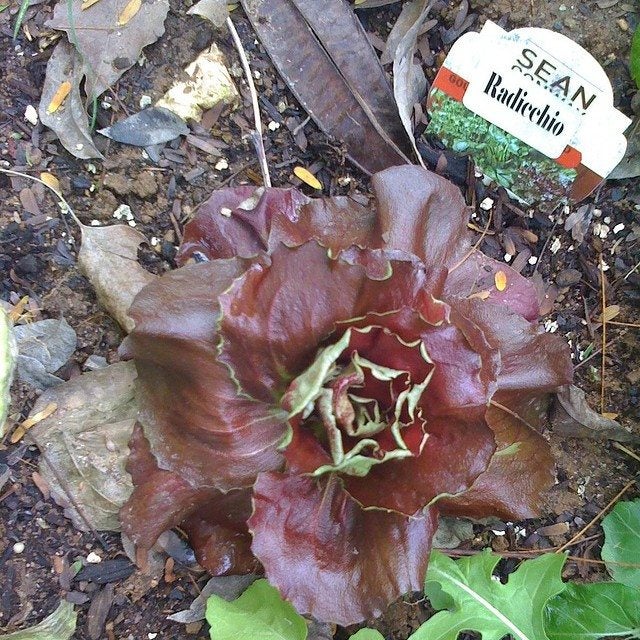Radicchio Growing - How To Grow Radicchio In The Garden

If you have a desire to expand the types of salad greens you routinely use, you may want to try radicchio growing. There are a few radicchio varieties to choose from, all of which are easy to care for and grow.
What is Radicchio?
Radicchio is a member of the Chicory family (Asteraceae), commonly found and utilized in many areas of Europe. Radicchio's popularity has more recently crossed the pond and is now commonly utilized in restaurants in salads, sautéed, and often used as a garnish due to its ruby hue. Radicchio (Cichorium intybus) can now be found at farmers markets and even the local grocery produce department. Radicchio has burgundy colored leaves with white ribs, resembling a small cabbage head, and is not to be confused with radichetta, another chicory type with the red coloration but lacking the heading form. Radicchios leaf texture is similar to that of the French endive, another popular heading chicory variety.
How to Grow Radicchio
Depending on your USDA zone, radicchio may be grown as a spring, summer, or fall vegetable, but the most common red leaf heading radicchio does best grown in cool temperatures. Radicchio is frost tolerant for a short period of time and growing temperatures may range as great as from 30 to 90 degrees F. (-1 to 32 C.). However, higher temperatures for any length of time will burn the leaves of the radicchio. While the plant prefers plenty of sunlight, it tolerates shade in the garden as well. Radicchio will grow in a variety of soil conditions from sandy to clay-like loam, but it much prefers a soil pH of 7.5 to 8.0, excellent drainage, and adequate irrigation. Radicchio can be direct seeded or transplanted depending on the time of year and what climate you are in. If transplanting, start the seeds indoors four to six weeks before transplantation. Generally, you should direct sow after the danger of frost has passed. Plants should be 8 to 12 inches (20-31 cm.) apart in the row depending on the cultivar. Maturation occurs around the 125 to 130 day mark. Radicchio plants need a constant amount of irrigation due to their shallow roots and to encourage the growth of the tender shoots.
Radicchio Varieties
There are many varieties of radicchio intended for optimum commercial growth in specific climes. A couple of types, which can be found in a good seed catalogue, include:
- ‘Guilo' - performs well in most of the country and is planted in spring or early summer, or seeded in the fall through winter for climates similar to Florida.
- ‘Augusto' - recommended for planting in late August for fall crops.
Care of Radicchio Pests
Radicchio plants are often attacked by the same types of pests as the cabbage family such as aphids, many beetle types, thrips, and ants. The care of radicchio affected with these pests can be countered by any number of chemical or biological controls. Consult with your local garden supply on methods of control related to your specific insect invader, type of plant, and climate. Radicchio is not only susceptible to the harsh effects of the sun and a sundry of pests, it can also be affected by a variety of fungal issues and powdery molds. These usually occur due to inadequate drainage and are most common in areas of the country with extremely wet conditions.
Gardening tips, videos, info and more delivered right to your inbox!
Sign up for the Gardening Know How newsletter today and receive a free copy of our e-book "How to Grow Delicious Tomatoes".

Amy Grant has been gardening for 30 years and writing for 15. A professional chef and caterer, Amy's area of expertise is culinary gardening.
-
 Try The Trend – Turn Any Bed Into A Keyhole Garden With This Clever In-Ground Composter
Try The Trend – Turn Any Bed Into A Keyhole Garden With This Clever In-Ground ComposterKeyhole gardening is an efficient and sustainable practice that saves space. Get started on this DIY project quickly and easily with an in-ground composter.
By Bonnie L. Grant
-
 4 Superfast Composting Methods: Turn Waste Into Garden Gold In 30 Days Or Less
4 Superfast Composting Methods: Turn Waste Into Garden Gold In 30 Days Or LessTry the fastest composting methods to turbocharge your pile and transform kitchen scraps and garden waste into finished compost in just a few weeks.
By Mary Ellen Ellis